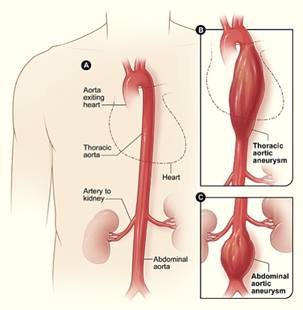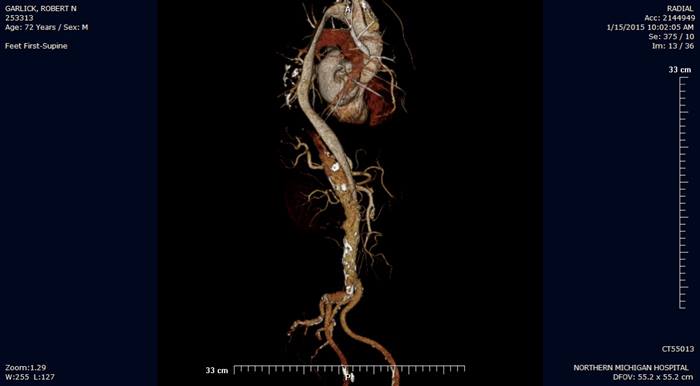Vascular Surgery
Thoracic & Abdominal Aneurysms
Thoracic Aortic Aneurysm and dissection

An Aneurysm is a condition in which the Aorta, the main artery from the heart, grows abnormally large over time. As the aneurysm grows, the aorta becomes weaker and eventually becomes thin enough to burst (rupture). A ruptured aortic aneurysm is a catastrophic condition that can quickly lead to death from massive internal bleeding if not treated emergently. An aneurysm that has not ruptured must be monitored carefully by health professionals until they reach a size where there is a significant risk of rupture. An aneurysm that occurs in the thoracic aorta in the chest beyond the arteries to the head and neck is called a Thoracic Aortic Aneurysm (TAA). Aneurysms can also involve both the chest and abdomen (thoracoabdominal aneurysm, TAAA). Finally, aneurysms can also involve the ascending aorta or arch; these are treated by cardiac surgeons because of the need for cardiac bypass.
Symptoms
Most patient with aneurysms have no symptoms unless the aneurysms is in the process of rupture. Some of these symptoms include:
- Severe chest, back or abdominal pain
- A pulsation sensation almost like your heartbeat but much more intense in the abdomen.
Risk Factors
Risk factors for Abdominal Aortic Aneurysms and Thoracic Aortic Aneurysms include:
- Smoking
- High Blood Pressure
- Family history of aneurysms
- Increasing Age
- Connective tissue disorders
- Bacterial Infections
Diagnostic tests
Diagnostic test are mostly non-invasive imaging tests that determine how big the aneurysms are. Most aneurysms without symptoms are discovered incidentally when patients receive tests for other indications. These include:
- Aortic Duplex scan (Ultrasound)
- Computerized Tomographic Angiography (X-ray)
- Magnetic Resonance Angiography (a type of MRI)
Treatment Options
Aneurysms without symptoms that become large enough to be repaired (about 5 cm in diameter or 2 inches) can be repaired using conventional surgery or using newer techniques that utilize stent grafts. At USF, our surgeons have expertise in both complex open surgical repair of Abdominal Aortic Aneurysms and with the latest, cutting-edge stent graft technology.
- https://www.nlm.nih.gov/medlineplus/ency/article/001119.htm
- https://vascular.org/patient-resources/vascular-conditions/thoracic-aortic-aneurysm
Aortic Dissection
IntroductionAortic Dissection refers to a fairly uncommon condition in which the aorta, the main artery from the heart, develops an internal tear. Aortic dissections can cause severe chest or abdominal pain and can be easily mistaken for a heart attack. If the tear continues to enlarge, vital organs such as the kidneys, the intestines, and even the legs can be severely damaged. These are emergent conditions that require specialized care in an intensive care unit setting. Some patients with injury to vital organ require emergent life-saving procedures.
Symptoms
Symptoms are severe, “tearing” chest, back or abdominal pain. The onset is usually sudden. Other symptoms can include paralysis of the legs and swelling.
Risk Factors
Risk factors for Aortic Dissections include:
- Uncontrolled High Blood Pressure
- Atherosclerosis (hardening of the arteries)
- Connective tissue disorders (such as Marfan’s syndrome and Ehler’s Danlos Syndrome)
- Traumatic Injury (such as hitting the steering wheel during a car accident)
Diagnostic test are mostly non-invasive imaging tests that determine the location and size of the aortic dissection. These include:
- Computerized Tomographic Angiography (X-ray)
- Magnetic Resonance Angiography (a type of MRI)
- Trans esophageal echocardiogram (Ultrasound of the Heart)
Initially, most patients with Aortic Dissections are stabilized and monitored in an intensive care unit setting with IV medications to strictly control blood pressure. Patients with organ damage or lack of blood flow to the legs require urgent interventions which can involve open surgical repair or the newer, aortic stent grafts. These are often complex procedures that require significant experience and expertise to complete. Fortunately, the Vascular Surgeons at USF are authorities in the Tampa Bay region in terms of all complex aortic diseases.
- http://www.webmd.com/heart-disease/tc/aortic-dissection-topic-overview
- https://www.nlm.nih.gov/medlineplus/ency/article/000181.htm
Abdominal Aortic Aneurysm
IntroductionAn Aneurysm is a condition in which the Aorta, the main artery from the heart, grows abnormally large over time. As the aneurysm grows, the aorta becomes weaker and eventually becomes thin enough to burst (rupture). A ruptured aortic aneurysm is a catastrophic condition that can quickly lead to death from massive internal bleeding if not treated emergently. An aneurysm that has not ruptured must be monitored carefully by health professionals until they reach a size where there is a significant risk of rupture. An aneurysm that occurs in the abdominal aorta (usually below the arteries to the kidneys and intestines) is called an Abdominal Aortic Aneurysm (AAA).
Symptoms
Most patient with aneurysms have no symptoms unless the aneurysms is in the process of rupture. Some of these symptoms include:
- Severe chest, back or abdominal pain
- A pulsation sensation almost like your heartbeat but much more intense in the abdomen.
Risk factors for Abdominal Aortic Aneurysms and Thoracic Aortic Aneurysms include:
- Smoking
- High Blood Pressure
- Family history of aneurysms
- Increasing Age
- Connective tissue disorders
- Bacterial Infections
Diagnostic test are mostly non-invasive imaging tests that determine how big the aneurysms are. Most aneurysms without symptoms are discovered incidentally when patients receive tests for other indications. These include:
- Aortic Duplex scan (Ultrasound)
- Computerized Tomographic Angiography (X-ray)
- Magnetic Resonance Angiography (a type of MRI)
- http://www.vascularweb.org/vascularhealth/Pages/abdominal-aortic-aneurysm.aspx
- https://www.nlm.nih.gov/medlineplus/ency/article/000162.htm
- https://vascular.org/patient-resources/vascular-conditions/abdominal-aortic-aneurysm

